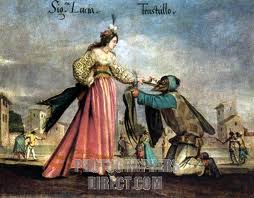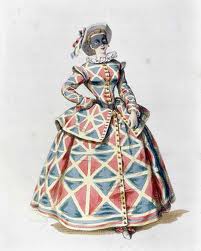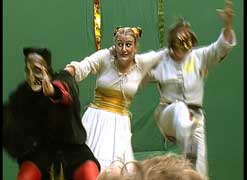This is the first part in a series of six from a speech I held at the Royal Dramatic Theatre in Stockholm together with Inga Lewenhaupt and Björn Granat and as moderator: Lennart Grafström. It was about Commedia dell’Arte and it’s relevance in a modern context.
I thought that it would be appropriate in this blog. But in order to make it readable I have divided it in six parts. So see also: part two, three, four, five or six. This is the first part:
Women in Commedia dell’ Arte
One place where Commedia dell’Arte is growing the most nowadays is at theatre schools. There are about 80% women in most theatre schools. The girls are not happy just playing the few women’s characters there are in Commedia dell’Arte. They want to play in a mask.
That is interesting since, during the renaissance, Commedia dell’Arte was the only form of theatre where women where allowed on stage.
LISTEN UP! There has never been any tradition anywhere on earth where women have worn masks. There have been men in mask playing women, but never women in mask. That makes what is happening right now extra interesting.
One way to solve this (except to let girls play men’s masks off course) is to make the men’s masks more feminine. That is fairly easy with different zanni masks, since they are not as sexual in their character. Arlecchina and the wife of Pulcinella are already traditional masks.
That solution gets more problematic when it comes to Pantalone and Capitano for instance. Commedia dell’Arte with its roots in the May rites has a strong sexual attitude. The masks of some of the characters are strong, obvious representatives of male sexuality. A Pantalona or a Capitana becomes plain stupid since they lack their roots in history and their role as inner stereotypes.
Dell’Arte International School of Physical Theatre in California even made their own mask:” Stupina”. She is an offspring from Stupino a mask that was created by Gina Bastone from misunderstanding of Coviello.
I usually solve the problem by either simply changing gender in the ensemble or if there is an all women cast (it happens a lot) simply letting the women play both the male and female masks. In the first case it becomes a play within the play about gender, much in the spirit of the up-side-down world of carnival. In the second case it becomes less weird since the world that has been created only contains female actors and there are really no rules to break, so to speak.
But what might be the most interesting way to relate to this is to develop the existing classic, female characters (Servetta, Signora and the Innamorata).
The Servette can be deepened and develop into more specific characters:
Smeraldina – as an anxious worrier or a very foolish maid servant, almost a female zanni but a bit less grotesque.
Vittoria – a scheming black-widow or plotting seductress (sometimes an older sister).
Flaminia – as the hot tempered or the more dippy, sappy, overly emotional young lover.
Columbina – as the smart, flirtatious, or a day dreamer and trickster or a younger, more older sister style maid, very confident in herself and her sexuality, often teasing, very clever.
Franschescina – as having common sense, but frustrated about by stupid people/men or an older, more motherly maid, possibly somewhat foolish and more bawdy in her flirtations.
Ricciolina – a young, assistant maid that isn’t flirty or sexual but smart and wise way beyond her years.
(I got these ideas from Jess Rudolph from the Players’ Patchwork’d Productions and Ian Thal from Teatro delle Maschere)
Signoras are already traditionally divided into older brothel keepers or married-for-money-type while the younger ones are either regular prostitutes or courtesans.
The Innamorati may be developed in to the teenager types of today.
And then we have Isabella – the exception to the rule. A character built on the real character of Isabella Andreini, she is the strong, intellectual woman.



5 Responses to Women in Commedia dell’Arte (the Royal Dramatic Theatre – speech part 1)